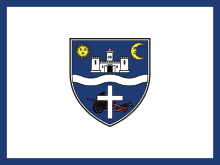Ungarndeutsche | |
|---|---|
 The flag of the German minority in Hungary | |
| Total population | |
| 142,551 (2022) | |
| Regions with significant populations | |
| Hungary | |
| 24,994[1] | |
| 22,150[2] | |
| 18,278[3] | |
| 10,195[4] | |
| 9,528[5] | |
| 9,168[6] | |
| 8,473[7] | |
| 5,419[8] | |
| 5,145[9] | |
| 3,039[10] | |
| Languages | |
| Hungarian, German | |
| Religion | |
| Roman Catholic majority, Protestant minority | |
| Related ethnic groups | |
| Danube Swabians, Germans (in particular Swabians) | |
Lived in Hungary (formerly the Kingdom of Hungary) since the Middle Ages onwards. | |
German Hungarians (German: Ungarndeutsche, Hungarian: magyarországi németek) are the ethnic German minority of Hungary, sometimes also called Danube Swabians (German: Donauschwaben, Hungarian: dunai svábok), many of whom call themselves "Shwoveh" in their own Swabian dialect. Danube Swabian is a collective term for a number of German ethnic groups who lived in the former Kingdom of Hungary, including the Kingdom of Croatia-Slavonia and Vojvodina. Other ethnic German groups previously lived on the territory of both the former Hungarian kingdom as well as on the territory of present-day Hungary since the Middle Ages onwards, most notably in Budapest but not only. As of the 2022 census there are 142,551 German speakers in Hungary.[11]
Hungarian Germans refers to the descendants of Danube Swabians who immigrated to the Carpathian Basin and surrounding regions, and who are now minorities in those areas. Many Hungarian Germans were expelled from the region between 1946 and 1948, and many now live in Germany or Austria, but also in Australia, Brazil, the United States, and Canada. However, many are still dispersed within present-day Hungary.
- ^ "Központi Statisztikai Hivatal". www.ksh.hu.
- ^ "Központi Statisztikai Hivatal". www.ksh.hu.
- ^ "Központi Statisztikai Hivatal". www.ksh.hu.
- ^ "Központi Statisztikai Hivatal". www.ksh.hu.
- ^ "Központi Statisztikai Hivatal". www.ksh.hu.
- ^ "Központi Statisztikai Hivatal". www.ksh.hu.
- ^ "Központi Statisztikai Hivatal". www.ksh.hu.
- ^ "Központi Statisztikai Hivatal". www.ksh.hu.
- ^ "Központi Statisztikai Hivatal". www.ksh.hu.
- ^ "Központi Statisztikai Hivatal". www.ksh.hu.
- ^ "Census 2022 – Final data – Main population characteristics". Census 2022. Hungarian Central Statistical Office. 2023-09-26. Ethnic affiliation. Retrieved November 1, 2024.
In terms of ethnicity, based on mother tongue and language used in family and with friends ...